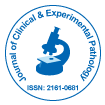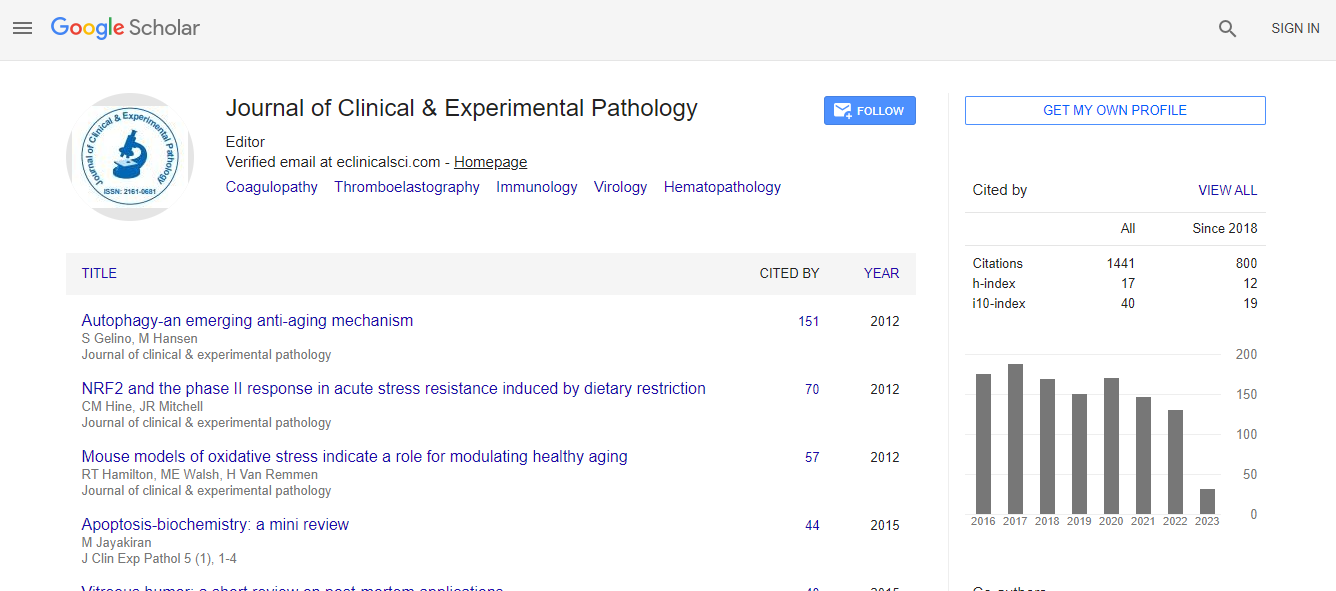Our Group organises 3000+ Global Conferenceseries Events every year across USA, Europe & Asia with support from 1000 more scientific Societies and Publishes 700+ Open Access Journals which contains over 50000 eminent personalities, reputed scientists as editorial board members.
Open Access Journals gaining more Readers and Citations
700 Journals and 15,000,000 Readers Each Journal is getting 25,000+ Readers
Google Scholar citation report
Citations : 2975
Journal of Clinical & Experimental Pathology received 2975 citations as per Google Scholar report
Journal of Clinical & Experimental Pathology peer review process verified at publons
Indexed In
- Index Copernicus
- Google Scholar
- Sherpa Romeo
- Open J Gate
- Genamics JournalSeek
- JournalTOCs
- Cosmos IF
- Ulrich's Periodicals Directory
- RefSeek
- Directory of Research Journal Indexing (DRJI)
- Hamdard University
- EBSCO A-Z
- OCLC- WorldCat
- Publons
- Geneva Foundation for Medical Education and Research
- Euro Pub
- ICMJE
- world cat
- journal seek genamics
- j-gate
- esji (eurasian scientific journal index)
Useful Links
Recommended Journals
Related Subjects
Share This Page
Prevalence and rapid diagnosis of acute bacterial meningitis in children in Bangladesh
Joint Event on 15th International Congress on American Pathology and Oncology Research & International Conference on Microbial Genetics and Molecular Microbiology
Mohammad Zakerin Abedin
University of Dhaka, Bangladesh
Posters & Accepted Abstracts: J Clin Exp Pathol
Abstract
An attempt was made to analyze the cerebrospinal fluid (CSF) profile and to isolate and identify aetiological agents from the specimens from children with suspected acute bacterial meningitis. Among total 79 samples, 65 (82.3%) were crystal clear, 9 (11.4%) were moderately turbid, 2 (2.5%) highly turbid and remaining 3 (3.8%) were high blood mixed. The total cell (leucocyte) count of the CSF was proportionate to the turbidity. In case of crystal clear CSF’s, total leucocyte counts were normally ranging from 0 to 700 per mm3 with predominant lymphocytes. Moderately turbid fluid showed 200 to 2,000 cells per mm3 and highly turbid fluid and highly blood mixed showed more than 40,000 cells per mm3. In the later cases, differential counts demonstrated polymorphonuclear predominancy. In 65 cases whose CSF were crystal clear, total protein and sugar concentration ranged from 20 to 400mg/dl and 20 to 180mg/dl respectively. In turbid CSF’s, total protein and sugar concentration varied from 70 to 500mg/dl and 10 to 200mg/dl respectively, while in the highly turbid CSF’s, they ranged from 50 to 800mg/dl and 40 to 140mg/dl respectively. Among total 79 CSF samples, Pandey’s tests were positive for 16.9% and negative for 9.2% in cases of the crystal clear. In case of moderately turbid and highly turbid CSF’s, Pandey’s test was positive for 88.9% and 100% cases respective. C-Reactive protein (CRP) were positive (>12mg/dl) for 3 (3.79%) samples. A total of 79 CSF was culture. There were 5 culture positive cases, which included Escherichia coli (20%), Haemophilus influenzae (20%) and Streptococcus pneumoniae (60%). Using the latex agglutination test, the detection rate was higher than that of culture. Most of meningitis positive cases showed an increased total cell counts as well as proteins concentration and decreased serum sugar concentrations. High resistant rate to cotrimoxazole was observed among the invasive isolates. On the other hand, none of these invasive strains showed resistant to ceftriaxone.Biography
E-mail: zakerin.du2016@gmail.com

 Spanish
Spanish  Chinese
Chinese  Russian
Russian  German
German  French
French  Japanese
Japanese  Portuguese
Portuguese  Hindi
Hindi 
